more about thimbles

Magdalena and William Isbister.
My wife and I have been collecting thimbles since 1971 and in 1990 I was appointed Chairman of the Department of Surgery at the King Faisal Specialist Hospital and Research Centre (KFSH&RC) in Riyadh in the Kingdom of Saudi Arabia. We both thought that this opportunity would enable us to learn more about the thimbles of the Islamic World and the journey of the thimble from its simple beginnings in the Far East, to Europe and back to the Middle East of today.
Some fifty million years ago man’s ancestors were evolving in the Great Rift Valley in sub equatorial Africa. As they evolved further they migrated eastwards and around two million years ago Homo Erectus was living in what is now called China. About eight hundred years before the birth of Mohamed, the cultures in Iron Age Europe, India and the Middle East were concerned with the development of wrought iron. It was in China, however, that the metal smiths of the day, the descendants of Homo Erectus, began to cast iron, and it was not long before hardened steel (often called ‘Iron’ by the people at the time) was being made by the process of a ‘hundred refinings’ (1). This allowed the production of very fine, sharp and strong needles. Previously needles were made of bone, copper, bronze and gold, tended to be rather big and clumsy and easily bent out of shape. They did not withstand strong pressure so that there was no need for any sort of pushing tool. They were no use for fine work and would not stand very strong pushing pressures. The invention of the steel needle allowed very fine work with silk and necessitated some form of light pushing implement which was the forerunner of the present day thimble. Initially it took the form of an open flat band like a finger ring which is possibly similar to the 19c ring shown in Figure 1.

Fig 1
A single steel needle from the time of the Han Dynasty (206BC - 202AD) was found in a tomb in Jiangling, and it must be assumed that thimbles were in use at this time, although no thimble seems to have been discovered with the needle. During the Cultural Revolution, in the tomb of a Han Princess, in Mawangdui, Hunan Province, steel needles and a thimble were found together (2).
Scythian tribes lived on the Northern Black Sea coast, including the Crimean peninsula, from the 7th century BC to the 2nd century AD (Fig 2). They relied on the subjugation of the agricultural populations in the region and the plundering and taxation of the neighbouring peoples for their livelihood. They captured and probably plundered Greek cities on the western Black Sea coast.

Fig 2
Chersonesus Taurica (Fig 3), in the south-western Crimea has been extensively excavated.

Fig 3
During one of the excavations of a Scythian settlement in the area, a thimble (Fig 4) in the same layer as silver coins, minted in Chersonesus in the 2nd century BC, was found (3). This must be the first thimble to have been found in Russia. It is similar in date to the first Chinese sewing ring found in a Han tomb and may have been of similar design (although closed) to the Han thimble since thimbles may have travelled relatively quickly along the northern silk route to the region of Scythia.
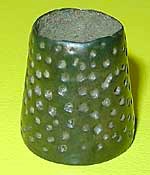
Fig 4
Over the succeeding years the Han expanded further into Central Asia and trading routes (Fig 5), the so-called silk routes (‘silk road’), opened up to the north west of the Han Empire and eventually reached Damascus and Antioch. From these eastern Mediterranean ports goods were taken further west by sea to Constantinople and Rome. Needles followed the silks and thimbles followed the needles.

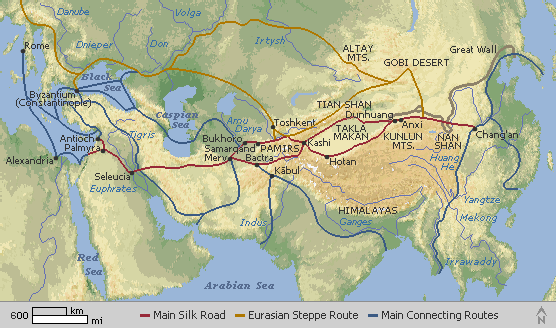
Fig 5
Han type needle rings, now closed and cast in one piece, were found in Puli (Tashkorgan), along the silk route (4), and are similar to those found in Byzantine excavations in Antioch and Corinth (5).

Fig 6
This thimble was found in Turkey (Fig 6) and is similar to those thimble rings found in Puli. It is made of cast bronze and dates between the 10th and 12th centuries.
For some unknown reason the Romans do not seem to have used metal thimbles for sewing. There is no known explanation for this; it may be that leather and material finger guards proved to be sufficiently robust and malleable for the purposes of the Romans. To this date there has been no well-documented archaeological data to link metal thimbles to any Roman site ever excavated. There are what are claimed to be ‘Roman thimbles’ in museum collections but the provenance, if any, of these thimbles is not robust and many have recently been removed from display so that it must be concluded that metal thimbles, as we know them, were never used in the Roman Empire.
There is thus a gap of some hundreds of years since the use of the thimble in China and it’s reappearance along the silk route. Fine steel needles were rare and expensive and it may just be that there were not many people who needed to use a metal thimble for many years?
The silk route extended through what is now known as Afghanistan and as the use of the thimble extended towards the west so the shape changed slowly too. Both small open and topped thimbles have been found in Afghanistan and Syria.



Fig 7 Fig 8 Fig 9
These three thimbles were found in Northern Afghanistan (Figs 7, 8, 9). The left hand thimble is open topped and derives from the open rings of China. It is cast bronze and probably dates to the 10th century. The second thimble, is a little later, is also cast but now has a top. There are also three crescents around the rim. The third thimble may be a development of the second thimble in that the three rim crescents now extend up to the top of the thimble where there is a small knob. The thimble is very similar to those excavated at Hama in Syria (Fig 11). A similar thimble (Fig 10) was found in Afghanistan and has a distinct rim.



Fig 10 Fig 11
These thimbles with a chevron motive separating three hand-dimpled panels (Figs 9-11) are called Hama thimbles (Abbasid-Levantine) after the town where two were found during a Danish pre WW ll excavation. The Danes excavated in the ancient town where the mount of the ancient citadel was situated (6). They were dated to between the 12th and 15th centuries so that together with the earlier Afghani thimbles (Fig 9, Fig 10), they may have been made during the time of the Abbasid Caliphs in Baghdad.
The Abbasid era began with the murder of Marwan ll, the last Umayyad Caliph of Damascus, in 656 AD. The Abbasid Caliphs ruled from Baghdad until 1258 AD and oversaw the ‘Golden Age’ of Islamic science and culture. Their empire was the largest that the world had known at the time and was bigger than the empire of Alexander the Great. The term ‘Abbasid-Levantine thimbles’ (7) describes thimbles found in the ‘Levant’, the Mediterranean lands east of Italy, including Syria and Jordan. They were thought to date a little earlier than the other cast bronze thimbles of the region and were considered to be the rarest of the Islamic styles. It has been suggested (8) that ‘it was the Abbasid-Levantine style thimble which returning Crusaders introduced to pre-Renaissance Europe’ and which was the shape adopted by ‘western European thimblers’.

Fig 12
Hama is a city on the banks of the Orontes River in central Syria. The ancient settlement, originally known as Hamath, was occupied from the early Neolithic to the Iron Ages, is famous for its giant irrigating water wheels (Fig 12), which it is claimed date back to 1100 BC, and is presently the fourth largest city in Syria.
The spread of Islam is intimately linked with the further journey westwards of the humble thimble. As the Arab armies moved west and Islam spread to North Africa and Spain so did the thimble. It was a different and much heavier work thimble and was most probably used for heavy sewing such as sail making or leatherwork. Lighter thimbles have not been found alongside of these heavy thimbles and this may be because any personal sewing undertaken at the time may have been supported by leather or material finger guards (Fig 13).
The thimbles of the Northern silk route were more bulbous and heavier than the thimbles found in Hama.


Fig 13 Fig 14
The thimble shown in Figure 14 is a cast iron thimble and was found in Bulgaria and dates to the 12th or 13th centuries. It may be the forerunner of the so-called ‘ Turko-Slavic’ thimbles (Figs 15-20).


Fig 15 Fig 16



Fig 17 Fig 18 Fig 19

Fig 20
The Turko-Slavic thimbles were heavy and bulbous. Dimpling was made by hand and the thimbles were cast in either bronze or iron (Fig 19). They often had ventilation holes and or a six-pointed star at the top and were sometimes grooved around the rim. They date from about the 10th to the 16th century.
In North Africa and Spain a different type of heavy Islamic thimble has been found. Their appearance mirrors the development of the forging of steel, brought to Cordoba by the Moors from Damascus, and the manufacture of steel needles in Spain. The thimbles are usually cast in bronze, although these thimbles have been found in both silver and gold, they date from the 10th to the 12th century (Fig 21). They may have long pointed tops and often a decorative band, sometimes they have an ancient Arabic inscription. They are known as Hispano-Moresque thimbles. It is not known why the Turko-Slavic or Hispano-Moresque thimbles took the shape that they did. They were probably heavy because they were used for sewing leather and sailcloth. They all seem to have been cast by the lost wax technique.
The earliest mention of a thimble in the literature is to be found in a poem – ‘The thimble’. It was written by a Moorish poet called Al-Liss who was born in Seville in about 1108. It has been translated (9):
‘Tis like a helmet, nicked
Where thrusting lances pricked;
Some sword has dispossessed
The helmet of its crest.
In the text the Arabic word for thimble, ‘kustubãn’ is used and it is thought that this derives from the Persian word for finger protector (angushtvãn) which was usually made of leather and used in archery. This derivation provides further evidence of the westward evolution of the thimble. The description of the thimble in the poem closely fits that of an Hispano-Moresque thimble (Fig 21) and the poem was included in an anthology which was created in 1243 by Ibn Sa’aid, from Andalusia, called ‘The Pennants of the Champions and the Standards of the Distinguished’.



Fig 21
In the Middle Ages thimble production moved north and for many centuries was cantered in Nürnberg. In Nürnberg in the 15th and 16th centuries, there was a well-organised brass casting industry and many ‘free tradesmen’ were working as thimble makers and turned the cast blanks on a lathe and then either drilled or hammered indentations. Their thimbles were shipped, in large numbers, overland on pack horses and mules to Venice for export all over the world. Nürnberg thimbles have been found in several excavated sites in Syria. Thimble production during these times waned in the Islamic countries and does not seem to have developed any further in ways independent of European manufacture. The more delicate shapes of the European thimbles were embraced in the 18th century in Persia.
Persia
Very fine thimbles were made in Persia in the 18th and 19th century.

Fig 22
A very fine gold filigree thimble with a silver top is thought to have been made in Persia in the 18th century (Fig 22). The gold wire is much finer than the twisted wires seen in early English filigree thimbles and the Persian filigree is applied to a gold ground for stability.
During the Qajar dynasty, from 1794 to 1925, enamel working on precious metals was one of the significant forms of art in Isfahan. Qajar enamels depict figurative scenes including birds, flowers and portraits of youth and lovers, the so-called betrothal thimbles.



Fig 23 Fig 24
The betrothal thimble (Fig 23) was made in the early 19th century and is made of 22 ct. gold. It shows portraits of the bride and groom. A 19th century silver enamel thimble depicting bird scenes has a steel top (Fig 24). Both of these thimbles are very uncommon and were undoubtedly made for members of the aristocracy. It seems unlikely that these thimbles were made for sewing but rather as loving keepsakes.

Fig 25
An early 20th century silver (Fig 25), two-part thimble with floral embossing.
Iraq

Fig 26
Marsh Arabs are the inhabitants of the marshlands around the Tigris and Euphrates rivers in the south and east of Iraq along the Iranian border (Fig 26). Following the Sykes-Pico agreement in 1916 and approval of the League of Nations, Iraq became a mandate under British control in 1920.
In Ottoman times, silver workers in the town of Amara, situated a third of the way between Basra and Baghdad on the left bank of the Tigress, was known for its silver workers and their niello decoration. Niello is a black mixture of copper, lead and silver sulphides and is used for filling in designs in engraved or etched silver or other metal, prior to baking, in order to enhance the design. It is thought that the Egyptians were the first to use the technique, and in the Iron Age, the method soon spread all over Europe.
It is understood that the silver workers were mostly making jewellery and domestic ware prior to the First World War but during the war Amara became an important base for the British forces and was the site of the chief military hospital in the region. Many servicemen visited the local souqs and a demand for small souvenirs developed. Niello thimbles (Fig 27) were one of the souvenirs made for the occupying Europeans.



Fig 27
Thimbles are sometimes signed by the maker and depict life in the marshes. Camels, sail boats, reed boats with upturned prows rush houses, palm trees, mosques and the square based tomb of Ezra’s on the banks of the Tigris are all to be seen on the thimbles. Probably most of the silver workers were Sabeans but it is likely that many were Moslems too.
Nomadic thimbles
The nomadic tribes of Afghanistan and Turkmenistan to have been making two part highly decorated thimbles in both silver and gold since at least the middle of the 18th century. We do not know of thimbles from an earlier time except those of the 13th century (Figs 7-10).
Afghanistan


Fig 28
Silver applied filigree thimbles with and without turquoise stones (Fig 28)
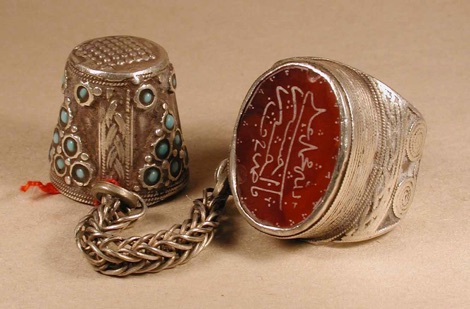
Fig 29
Silver thimble (Fig 29) with small turquoise stones attached to ring with carnelian stone engraved in Arabic script 'Allah, Mohammed, Ali (Mohammed’s son), Fatima (Ali's wife), Hassan and Hussein (Ali and Fatima's sons)'
Turkoman
These thimbles date from the mid 19th century and are often parts of elaborate gold and turquoise bridal hand decorations. Many thimbles are attached to decorated finger rings and most are made of silver with applied gold decoration.
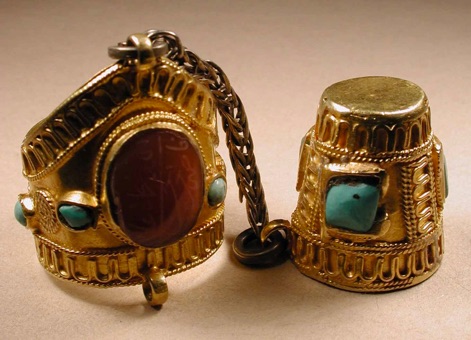
Fig 30
21k gold, applied filigree, thimble and ring (Fig 30), set with turquoise and carnelian stones, and joined by a silver chain. Probably part of a wedding decoration.
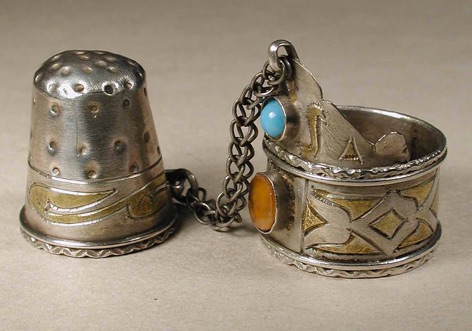
Fig 31
Engraved silver thimble with gilded design attached, by a silver chain, to a silver and gilded, crown shaped, ring with inset carnelian and turquoise stones (Fig 31).
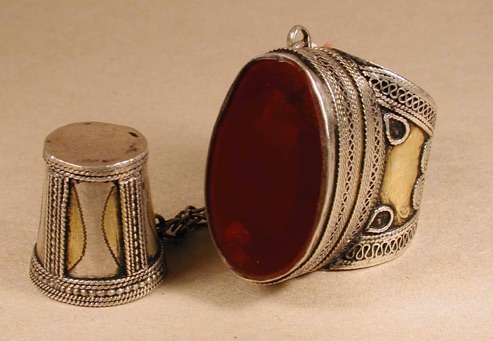
Fig 32
Silver thimble with applied filigree border with gilded patterns, applied filigree rim. Thimble attached to ring with silver chain. Silver filigree and gilded ring with 2.8 cm. carnelian stone (Fig 32).
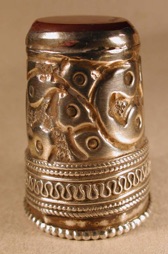
Fig 33
Embossed silver thimble with applied filigree border and applied beaded rim (Fig 33). The thimble has a carnelian stone top and was probably made in the 20th century.
Saudi Arabia
One might that have thought that the nomadic peoples of the Arabian Peninsular would have made thimbles in the same way as the nomadic peoples to the east but this seems not to have been the case. At KFSH&RC, a major referral hospital in Riyadh, patients came from all over the Kingdom. I thought that these patients, coming from different tribes, would be both a good source of intelligence and source of ‘old’ nomadic thimbles but sadly I was wrong, as time was to show.
My sojourn in the Kingdom was to last for 11 years, and during this time I tried to find out as much as I could about local thimbles. I soon learned that kustubãn was Arabic for thimble but it was much more difficult to find a word for thimble which was understood by anyone in Saudi Arabia. Al-kustubãn did not seem to mean anything at all. I asked surgical trainees whether they knew the word, but despite my drawings and hand gestures, I drew a blank. They just did not know anyone who sewed, except for surgeons, and generally they did not use thimbles! I tried to ask a few patients with the help of the trainees, who acted as interpreters, but they could not really see the relevance of my questions, and again I drew a blank. One day I was discussing my quest for local thimbles with clinic nurses, when a Palestinian nurse said that she knew the Arabic word for thimble, kustubãn. From then on, she became my main translator and communicator in my search for the elusive Saudi thimble. I asked her to tell the patients that I was trying to find ‘old’ thimbles.
Over the following months it became apparent that few Saudi women did any sewing and thus did not own thimbles or have any knowledge of thimbles. In the more elegant families, the servants did any sewing needed, and their mistresses knew little of what they did. In the poorest families it seemed that sewing was done without the help of a thimble. In days gone by girls were sewn into their dresses. The sleeves were very tight, and the seams had to be sewn and unpicked when the clothes were changed. In those times slaves probably did the sewing. Again no one seemed to know anything about thimbles. With the exception of the Hijaz, where pilgrim contact between the tribes and the outside world might take place, there was very little western influence in the Kingdom and it is unlikely, therefore, that the people were exposed to any western sewing tools.
Bedouin silver jewellery was usually made in Yemen by Yemeni silversmiths, who were often of Jewish descent and who signed their works in Arabic. Sometimes such a silversmith travelled in the Peninsula with one of the wandering tribes. We wondered whether they had ever made thimbles but despite an extensive search of most of the ‘antique shops’ in the Kingdom, we were unable to find anything resembling a thimble. There were rings of all types and sizes, gold with turquoise, gold with glass, and just plain silver but no thimble and nothing like the thimble and ring combinations that may be seen in Turkmenistan.
Towards the end of our time in the Kingdom, a new National Museum opened in Riyadh. The history of the Kingdom was documented in detail. There were pre-Islamic artefacts dating back many thousands of years, and amongst them were some gold and steel needles but not a thimble or anything resembling one. In the more recent collection, which dated back about 70-90 years, we did find several what looked to be thick leather finger covers, which were not described, but which had come from the Eastern Province (Fig 34). They were used by pearl divers to protect their fingers during diving from the coral or sea urchins. They were called jildiyyat al-ghawwas, literally, “divers’ leather things’. We never found any similar items outside of the museum.
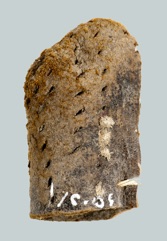
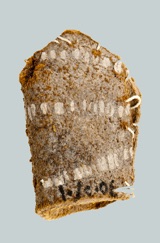
Fig 34
My patient enquiries had fared no better. One day an old lady brought me a small packet, which contained some small steel thimbles marked ‘Taiwan’. This made me realise that I was failing to explain that I was looking for ‘old’ thimbles. On each subsequent occasion, I stressed the word ‘quadim’. This strategy failed to produce any old thimbles either but I did amass quite a collection of modern West German and Taiwanese thimbles however. Saudis, in general, seemed to feel that ‘new’ things were best; hence they could not understand why I should be looking for “old” thimbles and in kindness brought me the better ‘new’ versions. Maybe they felt that I was asking for ‘old’ thimbles, because they were worthless, and they wanted to bring me a nice ‘new’ gift. Whatever the reason, I was not able to find anyone who would bring me something old.
Each spring at Al Janadriyah, 45 miles east of Riyadh, the National Guard organise a National Folklore and Cultural Fair. Crafts from all over the Kingdom are demonstrated. In a large courtyard building, set out like an old souq, the individual artisans can be seen working at their crafts. On one day during the festival, the grounds are opened to ‘families’ (men and women together), and since many westerners seem to attend on this day, the rules governing photography seem to be relaxed a little. It is thus possible to see and photograph people making coffee pots, guns, and baskets and to watch bookbinders and weavers at work. During one of our visits to Al Janadriyah, we saw an old man working with a quilt. He sat cross-legged on the floor and had a dimpled gold coloured ring on his right middle finger, which he used for pushing his needle (Fig 35).
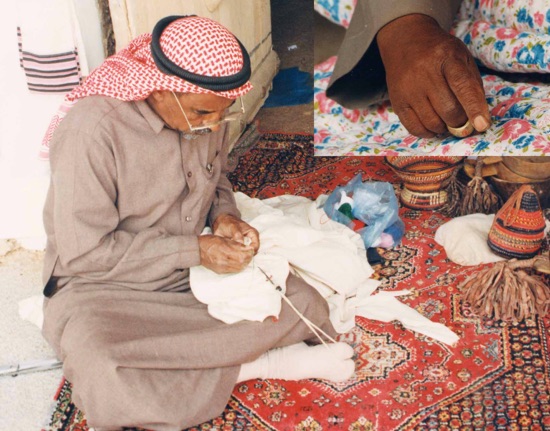
Fig 35
He maintained tension in the material by means of a hook, which was attached to his right great toe by a cotton band (Fig 36).
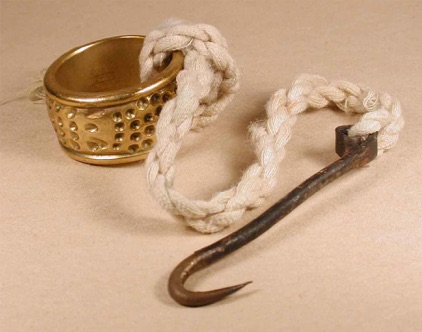
Fig 36
We had not seen anything similar in any other place. But, one day in the clinic, towards the end of my stay, I was surprised when a patient brought me a similar ring and hook and said that it had belonged to her grandmother. I was very excited and thanked her very much.
This was the first, arguably ‘old’ thimble that had been brought to the clinic, and I was very grateful.
Although I have a picture of an old man sewing with what looks like a white fabric finger protector (Fig 6), we never saw another during our stay. As we also collected Bedouin silver and other artefacts during our stay, we did search the antique souqs on a regular basis. We went to the “Antique souq” in Riyadh on many occasions. On our way we used to pass through other souqs, where men were often seen making leather sandals (without pushers), fur-lined cloaks, and mishlas. Many of the men were sitting cross-legged on the floor sewing, but at no time did we ever see any type of thimble. In the souq, I did find an ‘old’ Bedouin agal, which was decorated with some western brass thimbles (Fig 37).
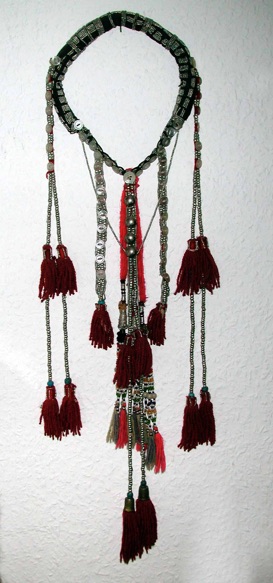
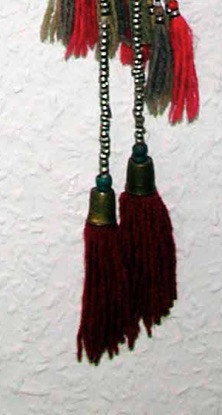
Fig 37
A similar use of thimbles for decoration has been used by Indian tribes in North America.
One day, a very old Bedouin lady, attending my clinic, passed me a parcel wrapped in Kleenex tissues. It contained two old ring-type ‘thimbles’, which she said were very old. They were the first signs of any thimble used by the tribes that we had seen and may have dated back about 100 years. I was very pleased that at last an older thimble had been found. One of the ‘thimbles’ may have been a silver decoration from the barrel of an old rifle, but it had been used for sewing too (Fig 38).
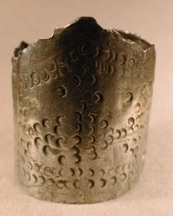
Fig 38
The other, was probably, a ring-type thimble and it too had been used for sewing by her great-great-grandmother (Fig 39).

Fig 39
Throughout our stay in Saudi Arabia, we made regular trips to Dubai, because I was an examiner at the Medical College. Apart from the modern ‘western type’ thimbles, which we saw in souvenir shops, we were not able to find any old thimbles in Dubai either. More recently, however, we did find that in 2005, the United Arab Emirates had issued a set of postage stamps depicting pearl diver’s tools. The 125 Fils stamp shows a set of five, 5 cm. long leather ‘finger hats’ - khubaat (Fig 40). These protectors were worn by the fishermen to protect their fingers whilst they were handling of the oysters. Similar finger guards are in the collection of the National Museum in Riyadh (Fig 34) although they have a different name.
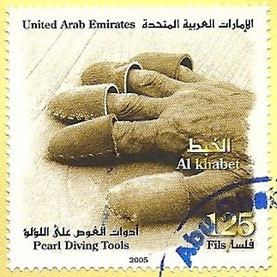
Fig 40
Our experiences in the Kingdom taught us that the mistress of the house rarely practised sewing and thus had little knowledge of the tools associated with the art. Cloth and leather finger protectors were used in relatively recent times and were probably the primary method of finger protection in the past, and, as in other countries where this was happening, few have remained for posterity. Ring-type thimbles may have been in use by some tribes, but the silversmiths never made them in large quantities and most were probably originally decorations for guns. Although exposed to many external influences over the millennia, particularly in the Hijaz and during Hajj, closed thimbles, as we know them today do not seem to have made their journey to the Arabian Peninsula until recently.
Modern thimbles
Probably as a consequence of increased tourist activity silver souvenir thimbles have become available in many Islamic countries. Yemeni silversmiths are also making souvenir thimbles in Israel
Turkey
In Turkey, ‘European type’ thimbles are made in silver and gold.
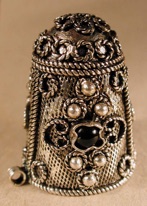
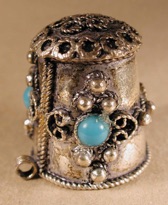
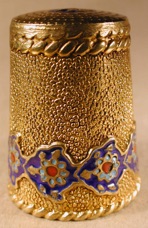
Fig 41 Fig 42
Two contemporary Turkish thimbles with ‘stones’ (Figs 41) are rather crudely made. They both have rings for the attachment of a chain and both are marked GAZI 925. Enamel flowers decorate this modern gilded silver thimble (Fig 42).
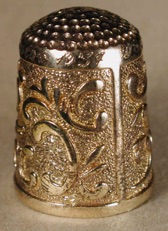
Fig 43
A 14 ct. gold thimble with a plain dimpled top and repoussé scrolls in two panels on the border. It is engraved "Valide Hanim 3 Augustos 1937" (Fig 43).
Souvenir thimbles
We have seen silver souvenir thimbles (Fig 44) from many Muslim countries (left to righ: Jordan, Oman, Indonesia and Israel), some are decorated with semiprecious stones and most have domed tops, possibly a reminder of their earlier origins.
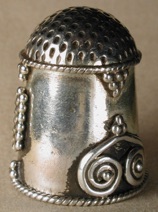
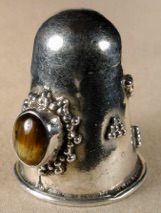
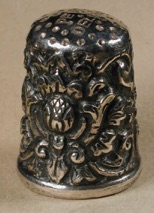
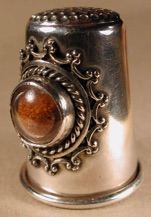
Fig 44
Advertising
European made advertising thimbles inscribed in Arabic may be found in the Middle East.
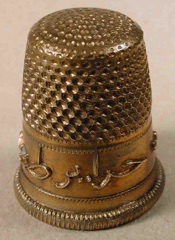
Fig 45
This brass thimble (Fig 45) was probably made in France in the 1920 and the Arabic text reads ‘Crease less natural silk textiles’.
Damascene
As the production of steel needles moved west so too did the production and decoration of swords. Damascus became an important centre for this industry and as the Ottoman Empire moved west to Spain so did the skills of damascening.
Damascening is the art of inlaying gold or silver into a darkly oxidized steel background. The term is derived from the resemblance of the damasked item to the patterns seen in damask silk. We have only seen gold used on thimbles and none are older than the 20th century (Fig 46). The thimbles were made in Germany (Gebruder Gabler GmbH, Schorndorf.) and sent to Toledo for band decoration. Many of the gold inlaid patterns are Islamic in style and clearly derived from Islamic culture.
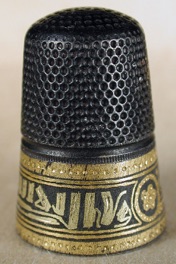
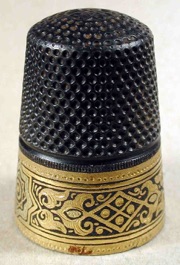
Fig 46
Man evolved eastwards towards China, and thimbles evolved westwards some time later in the opposite direction. Without the Islamic peoples, the Mongols in the east and the Arabs in the Middle East, North Africa and Spain, thimble making may never have reached Nürnberg and we might have been still pushing needles with an alternative sort of pusher today!
Acknowledgements
We are very grateful to Dr Abdullah bin Saud al-Saud, Director General, National Museum, Riyadh for providing the pictures of finger guards (Fig 34) from the museum’s collection.
References
1. Holmes EF. Thimble Notes and Queries 1992; 5: 6-9.
2. Holmes EF. A history of thimbles. London: Cornwall Books, 1985. pp. 16.
3. Klechinov VN. Scythian thimble. http://thimbles.ru/page.php?51
4. von Hoelle JJ. Thimble collector’s encyclopedia. Illinois: Wallace-Homestead Book Company, 1986. pp. 23.
5. Davidson GR. Corinth, Results of excavations conducted by the American School of Classical Studies. 1952; Xll: 175.
6. Plough G, et al. Hama, Fouilles et Recherches 1931- 1938 lV3. Copenhagen: Fondation Carlsberg, 1969. pp. 86.
7. von Hoelle JJ. Thimble collector’s encyclopedia. Illinois: Wallace-Homestead Book Company, 1986. pp. 29.
8. McConnel B. The story of the thimble. Atglen, PA.: Schiffer Publishing Ltd, 1997. pp. 11.
9. Holmes EF. A history of thimbles. London: Cornwall Books, 1985. pp. 19.
Holmes: 'Silver Thimbles' pp. 102.
Little thimble, big journey. Isbister WH. Saudi Aramco World September/October 2012
Researched and published in 2002/12
Copyright@2011. All Rights Reserved
Magdalena and William Isbister, Moosbach, Germany
Addendum 1/2015
Recent information concerning the Scythian thimble would suggest that the dating of the thimble may not be too robust and that it may, in fact, date to a considerably later period (600-800 AD). Several other similar thimbles or parts of thimbles seem to have been discovered in the Eastern Mediterranean from the same period although the literature relating to these thimbles is not available to us, and some are unpublished. They may have been made in China and exported with the silk and steel needles.

thimbles from the islamic world



Navigation
